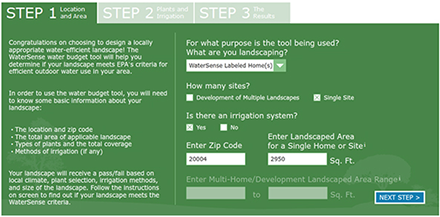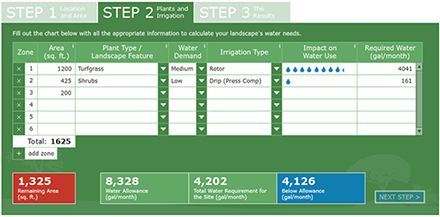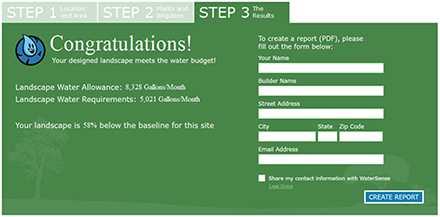WaterSense Labeled Homes-Outdoors
Landscape Design and Irrigation System Solutions
Depending upon where a home is located, the water used to maintain its outdoor landscape can total anywhere from 30 to 70 percent or more of the home's total water use. Water efficiency begins with designing a water-smart landscape. If irrigation is used, it's important to design it right and use technology that is water-smart.
What: Provide homeowners with attractive and water efficient landscapes that are easy to maintain.
Why: On average, single-family homes in the United States use 30 percent of their water outdoors. In some hotter and drier areas of the country, that number is as high as 70 percent! Regionally appropriate landscapes can also help homeowners cope with drought and comply in times of local watering restrictions.
How: The WaterSense specification addresses outdoor water efficiency through a combination of appropriate landscape design and efficient irrigation systems.
Landscape Design
The front yard of WaterSense labeled homes must be landscaped. The criteria also apply to any other areas improved upon by the builder beyond temporary stabilization (e.g., turf, sod, flower beds, water features). For multi-family buildings, all areas improved upon by the builder, including common-use areas intended for building residents, must meet specified landscape criteria.
To help builders and contractors design regionally-appropriate landscapes, EPA developed the WaterSense Water Budget Tool. All homes that earn the WaterSense label have landscapes that meet the requirements of this Web-based tool. Here are the steps how to use it:
Step 1 - Enter information on region and landscape, including zip code, plans for in-ground irrigation systems, and the area of the landscape. The Water Budget Tool will provide a Landscape Water Allowance based on local climate data and set a goal for landscape efficiency.
Step 2 - Input the general types of plants that will be used in the landscape (e.g., turfgrass, shrubs) and the water requirements (e.g., low, medium, high) of each. In this step, you also input what type of irrigation system, if any, will be installed.

Step 3 - Learn whether or not your landscape design meets the WaterSense specification—a simple “pass” or “fail.” For a home to earn the WaterSense label, the landscape water budget must stay under that Landscape Water Allowance from Step 1 in order to receive a pass. Your inspector will verify your Water Budget Tool calculations as part of the inspection process.

Other Landscape Considerations
After your landscape design has passed the Water Budget Tool, you might have a few more requirements to consider, depending upon the property:
| If... | Then... |
|---|---|
| Your landscape has exposed soil | Cover it with 2 to 3 inches of mulch. |
| The property has slopes greater than 4 feet of horizontal run per 1 foot vertical rise (4:1) | They need to be vegetated. |
| You plan to install a pool, spa, or ornamental water feature | Consult the WaterSense specification (19 pp, 250 K, About PDF) for specific requirements. |
Irrigation System Requirements
If your landscape design requires an irrigation system, there are additional criteria you need to meet:
WaterSense Labeled Irrigation Controller
- WaterSense labeled irrigation controllers allow watering schedules to better match plants’ needs by tailoring to local weather and actual onsite landscape conditions. Use our Product Search Tool to identify a WaterSense labeled model or simply look for the WaterSense label on product packaging.
Certified Irrigation Professionals
- Have your irrigation system designed or installed and then audited by irrigation professionals certified by a WaterSense labeled program, which teaches skills to improve landscape health and water efficiency. Use our directory of Certified Professionals to locate a certified professional in your area.

